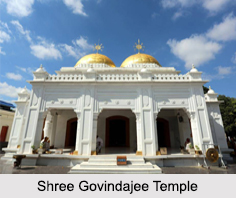 Located in the Imphal East District of Manipur, Shree Govindajee Temple is one of the largest historic centres for Hindus as well as Vaishnavites in the state. The main temple deity is Govindaji, who is the incarnation of Lord Krishna. Other than regular devotees, tourists are also attracted to Shree Govindajee Temple, especially during the time of Hindu festivals like Janmashtami and Kang or Ratha Yatra.
Located in the Imphal East District of Manipur, Shree Govindajee Temple is one of the largest historic centres for Hindus as well as Vaishnavites in the state. The main temple deity is Govindaji, who is the incarnation of Lord Krishna. Other than regular devotees, tourists are also attracted to Shree Govindajee Temple, especially during the time of Hindu festivals like Janmashtami and Kang or Ratha Yatra.
History of Shree Govindajee Temple
Originally built in 1846 by Maharaja Nara Singh of the Manipur kingdom, Shree Govindajee Temple was dedicated to the Hindu God Govindaji, who was the royal deity of the kingdom. The devastating 1868 earthquake substantially destroyed the temple and the deities. In the year 1876, the temple was rebuilt to its original design during the reign of Maharaja Chandrakriti. During the Anglo Manipur War of 1891 the idols of the temple were moved to Kongma. However in 1908 under the reign of Maharaja Churchand Singh, the idols were moved and re-consecrated in the present temple.
The 18th century Meitei monarch, Ching- Thang Khomba or Bhagya Chandra Karta was an ardent devotee of Lord Krishna. It is believed that he once had an epiphany from the Lord to build a temple. Accordingly in 1776, he formally initiated the carving of the idol of Lord Govindaji, which was then completed and consecrated in November 1779 on the full moon day in a temple built by him in his palace. Ching- Thang was the inventor of the Ras Lila dance form and the day of the consecration was celebrated while performing the Ras Lila dance.
Features of Shree Govindajee Temple
Built in an idyllic location with a well tended garden surrounding the premises, the Shree Govindajee Temple is situated over a square plan on a high platform. Made out of red bricks, the temple reflects a simplistic design with two gold plated domes, a paved court and a large, raised mandapa or congregation hall. The mandapa is double storied and is an independent structure within the enclosed premises of the temple. At the cornice level on the first floor a row of elephant heads are provided which support the inclined roof slabs. There is also a mini temple tower, which is built as an extension of the mandapa. In the temple premises, there is also another mandapa known as the Natyashala, which is a colonnaded structure with arcades, with idols fixed at the four corners of the roof.
The central chamber of the sanctum sanctorum or garbhagriha has the idol of the main deity Govindaji along with his consort Radha. In the other two chambers of the sanctum, on either side of the main deity, deified images of Balarama and Krishna are on one side, and images of Jagannath, Subhadra and Balarama are on the other side.
As per Article II of the Manipur Merger Agreement of 1949, the temple management was under the former king when Manipur became a part of independent India. However, on popular demand by the public, it is now managed by a Board with members drawn from the priest community and important people of the city. The Chief Minister of the state is the Board`s president.
Festivals of Shree Govindajee Temple
Shree Govindajee Temple celebrates important Hindu festivals like Janmashtami, the birth of Lord Krishna with much fanfare. The festival is celebrated during the month of August, while the Kang or Ratha Yatra is celebrated sometime during June to July and draws in large number of crowd. During Holi festival, Ras Lila is performed on the temple premises. The Shree Govindajee Temple is a popular place of attraction and is visited by devotees and tourists alike.
Visiting Information on Shree Govindajee Temple
The nearest railway station is at Dimapur at a distance of 209 km from the temple and the Imphal Airport is the closest at a mere distance of almost 8 km from the Shree Govindajee Temple.






